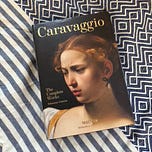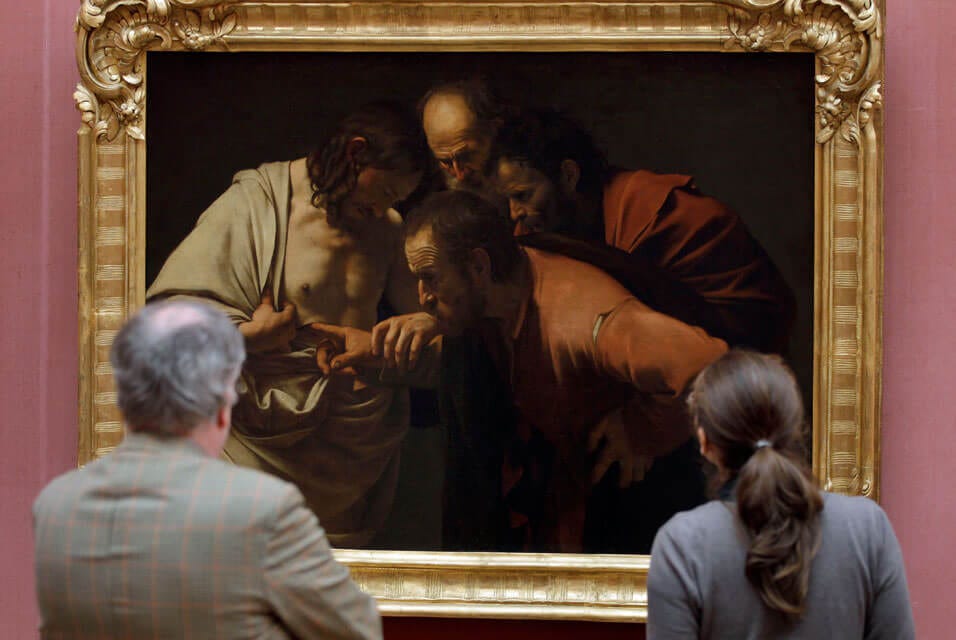Rome is calling me. Hello Pope Francis! The Pope has thrown open the cathedral doors, welcoming in the Jubilee—a special holy year in Rome, Vatican City, and across Italy. This Catholic celebration, which began just weeks ago at Christmas, will culminate with the Epiphany in 2026. A Jubilee year is a time for spiritual renewal, drawing millions of pilgrims to Rome in search of deeper faith and connection. With over 35 million visitors expected to flood the Eternal City, Rome is bracing for a chaotic season of reverence, celebration, and unparalleled energy. And considering most of the comedy I might attempt this year has to directly to do with the Catholic Church, I feel like it is time to stare down my Catholic imagination in-person.
As the city prepares for this momentous occasion, I find myself thumbing through Caravaggio’s catalogue raisonné once again and revisiting a reflection on one of my favorite paintings I have never seen in person. I have one that fits in my two hands like a Bible. I carry it around with me on the subway. [A catalogue raisonné is a comprehensive listing of all known works by a single artist, often accompanied by detailed documentation and analysis]. Each catalogue represents a sincere labor of love and dedication. Regardless, my descriptions can never capture the essence of Caravaggio's actual brushstrokes. Have you ever stood in front of a Caravaggio painting? Caravaggio's brushstrokes are sensuous, fulfilling, and mighty. I often struggle with justifying my writing about art. Why not just look and enjoy the painting? How might my words ever achieve close to what a Caravaggio brushstroke can?
They can’t. I don't shy away from embracing Caravaggio, the Baroque-era “bad boy” artist whose life and work were as provocative as his reputation. He must have loved the Bible or maybe it was because an Archbishop paid the bills? Catholics and the Knights of Columbus and Pro-Life fanatics around the world are still trying to divorce themselves from some of his jarring and erotic paintings. Not I, bring them on. He was able to bring such life to the stories of my Christian paradigm. Once I found a book on Caravaggio, I felt like I had found my first soft core porn. And I wondered how could these pictures have been paid for by the Church? Given what we now know about sexual and financial abuse controversies within the Catholic Church, these paintings seem like the least of their concerns.
Miraculously, the painter took a sentence from the Bible and shapes them into an entire world. I want to live in The incredulous Thomas painting depicting the Apostle Thomas flipping his finger into the side of Jesus. The incredulous Thomas, the unbeliever. Incredulous meaning the state of being unwilling or unable to believe something. I always felt like I could make a nice home in the furrowed brow of Thomas. Your eye is immediately drawn to the wound caused by a soldier, days prior while Jesus hung on the cross to ensure that he was dead. Proof. That is all you need. In the Bible, they clearly craft the doubt Thomas had of Jesus:
25 The other disciples therefore said unto him, We have seen the Lord. But he said unto them, Except I shall see in his hands the print of the nails, and put my finger into the print of the nails, and thrust my hand into his side, I will not believe.
Well, there it was in word and now in image. In 1602, this painting would have made a believer out of me. How many of us do not believe that mystery can exist? Particularly now in contemporary America. I am not even sure we could claim doubt, but more of Peter’s denial. Evangelical America has sided with the conservative Right and there is no room for faith anymore. No room for mystery. No room for unanswerable quests. There is definitely not any room for painting like Caravaggio.
I did not find this painting until later in life, well after my own personal cross hairs with the evangelical movement. The actual painting of Thomas lives in Potsdam, Germany outside of Berlin. How on earth does an Italian painting celebrating one of the many doubters of Jesus Christ’s resurrection end up in Potsdam, Germany? The painting's provenance—its documented history of ownership and authenticity—is clear. After a few Italian owners, it found its way in 1815 to the King of Prussia’s collection but deemed “unsuitable for the museums” and placed in the disposition of the Royal Household. It went on a “journey” during World War II and was found in Russia. It was not returned to Germany until 1958, where it now has a home in Potsdam for general palace goers.
There are only so many Caravaggio paintings left. I have seen four in person. Though I have never seen this painting in person, I believe in its existence, just as I believe in the enduring mystery and power of art to evoke faith, doubt, and wonder.













